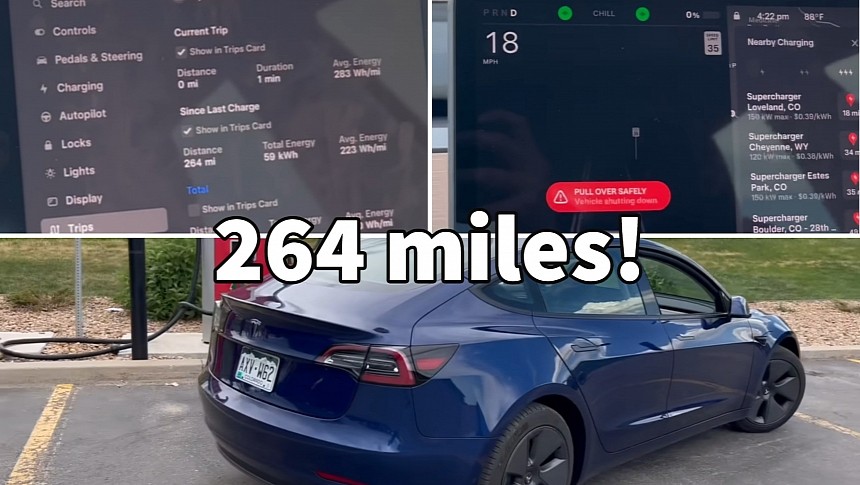LFP batteries have lower energy density but are also cheaper to produce. This makes them suitable for entry-level EVs like the Tesla Model 3 RWD. If you wondered how far you can drive on a highway in the base-model Tesla, Ryan from the Out of Spec Reviews YouTube channel has the answer.
Although most people know what Li-ion batteries are, few know that many types of such cells exist. The automotive industry mainly uses nickel-rich Li-ion cells, known as NCA (nickel-cobalt-aluminum) or NMC (Nickel-Manganese-Cobalt), because they have the highest energy density. This gives electric vehicles a better range with a relatively small battery pack. However, a new Li-ion battery type, known as LFP (lithium-iron-phosphate), is making inroads.
LFP batteries are cheaper to produce because they don't use nickel or cobalt, and iron is cheap and abundant. The downside is that they are heavier than their nickel-based counterparts, which affects energy density. In other words, you need a bigger and heavier battery pack to hold the same energy as an NCA/NMC pack). This makes it a low-cost solution used in entry-level electric vehicles or the base versions of the more advanced models. Even Tesla uses LFP batteries for the Model 3 RWD and Model Y RWD, although the latter is not sold yet in the US.
Since the LFP cells are not new, we already know they can be dependable and perform well as long as you use them according to the manufacturer's recommendation. Tesla recommends charging them to 100% on a regular basis or at least once a week. This surprised many people in 2021 when the first Teslas with LFP batteries started deliveries. The reason was that the battery management system needed this to calibrate since the voltage of LFP cells doesn't vary much with the state of charge. This also makes them less prone to degradation when they are charged fully.
In the end, LFP cells have both advantages and disadvantages. On the one hand, they have a lower energy density. Still, the fact that you can regularly use the full battery capacity partly compensates for this shortcoming. This allows Tesla Model 3 RWD to drive 272 miles (438 km) on a charge, which is still impressive. This is the EPA estimate, but driving the car faster on a highway can affect range. This is where the highway range tests offer more insight into how these batteries perform when the aerodynamics come into play.
Ryan from the Out of Spec Reviews YouTube channel took his Model 3 RWD to the extremes to show what it's capable of. He ran the famous 70-mph highway range test, where the car is driven at a constant speed of 70 mph (113 kph) on the GPS until the battery is completely depleted. Ryan took it to the next level this time, as the car died completely, and he had to push it to the charging station nearby.
In the end, the car went 264 miles (425 km), but that was using all the battery's buffer, which is not recommended if you care about battery health. That's pretty close to the EPA range, which is outstanding considering the driving speed. This speaks volumes about the Model 3's aerodynamic efficiency.
LFP batteries are cheaper to produce because they don't use nickel or cobalt, and iron is cheap and abundant. The downside is that they are heavier than their nickel-based counterparts, which affects energy density. In other words, you need a bigger and heavier battery pack to hold the same energy as an NCA/NMC pack). This makes it a low-cost solution used in entry-level electric vehicles or the base versions of the more advanced models. Even Tesla uses LFP batteries for the Model 3 RWD and Model Y RWD, although the latter is not sold yet in the US.
Since the LFP cells are not new, we already know they can be dependable and perform well as long as you use them according to the manufacturer's recommendation. Tesla recommends charging them to 100% on a regular basis or at least once a week. This surprised many people in 2021 when the first Teslas with LFP batteries started deliveries. The reason was that the battery management system needed this to calibrate since the voltage of LFP cells doesn't vary much with the state of charge. This also makes them less prone to degradation when they are charged fully.
In the end, LFP cells have both advantages and disadvantages. On the one hand, they have a lower energy density. Still, the fact that you can regularly use the full battery capacity partly compensates for this shortcoming. This allows Tesla Model 3 RWD to drive 272 miles (438 km) on a charge, which is still impressive. This is the EPA estimate, but driving the car faster on a highway can affect range. This is where the highway range tests offer more insight into how these batteries perform when the aerodynamics come into play.
Ryan from the Out of Spec Reviews YouTube channel took his Model 3 RWD to the extremes to show what it's capable of. He ran the famous 70-mph highway range test, where the car is driven at a constant speed of 70 mph (113 kph) on the GPS until the battery is completely depleted. Ryan took it to the next level this time, as the car died completely, and he had to push it to the charging station nearby.
In the end, the car went 264 miles (425 km), but that was using all the battery's buffer, which is not recommended if you care about battery health. That's pretty close to the EPA range, which is outstanding considering the driving speed. This speaks volumes about the Model 3's aerodynamic efficiency.











